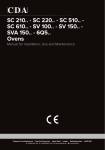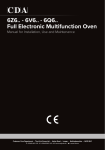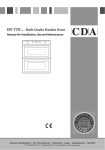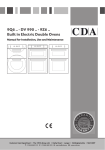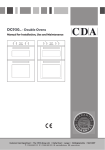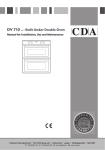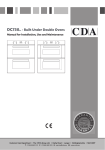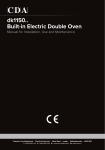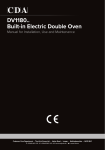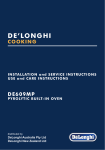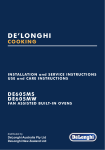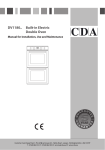Download CDA 9Z6 Specifications
Transcript
9Q6 .. - DV 990 .. - 9Z6 .. Built in Electric Double Ovens Manual for Installation, Use and Maintenance Customer Care Department • The Group Ltd. • Harby Road • Langar • Nottinghamshire • NG13 9HY T : 01949 862 012 F : 01949 862 003 E : [email protected] W : www.cda.eu Important This appliance is designed and manufactured solely for the cooking of domestic (household) food and is not suitable for any non domestic application and therefore should not be used in a commercial environment. The appliance guarantee will be void if the appliance is used within a non domestic environment i.e. a semi commercial, commercial or communal environment. The CDA Group Ltd cannot be held responsible for injuries or losses caused by incorrect use or installation of this product. Please note that CDA reserve the right to invalidate the guarantee supplied with this product following incorrect installation or misuse of the appliance. Appliance Information: Please enter the details on the appliance rating plate below for reference, to assist CDA Customer Care in the event of a fault with your appliance and to register your appliance for guarantee purposes. Appliance Model Serial Number Declaration of CE Conformity This oven has been designed, constructed and marketed in compliance with: - Safety requirements of EU Directive “Low Voltage” 2006/95/EC; - Protection requirements of EU Directive “EMC” 2004/108/EC; - Requirements of EU Directive 93/68/EEC. - Requirements of EU Directive 2011/65/UE. Important Information for Correct Disposal of the Product in Accordance with EC Directive 2002/96/EC. At the end of its working life, the product must not be disposed of as urban waste. It must be taken to a special local authority differentiated waste collection centre or to a dealer providing this service. Disposing of a household appliance separately avoids possible negative consequences for the environment and health deriving from inappropriate disposal and enables the constituent materials to be recovered to obtain significant savings in energy and resources. As a reminder of the need to dispose of household appliances separately, the product is marked with a crossed-out wheeled dustbin. 2 IMPORTANT SAFETY PRECAUTIONS AND RECOMMENDATIONS IMPORTANT: This appliance is designed and manufactured solely for the cooking of domestic (household) food and is not suitable for any non domestic application and therefore should not be used in a commercial environment. The appliance guarantee will be void if the appliance is used within a non domestic environment i.e. a semi commercial, commercial or communal environment. Read the instructions carefully before installing and using the appliance. • After having unpacked the appliance, check to ensure that it is not damaged and that the oven door closes correctly. In case of doubt, do not use it and consult your supplier or a professionally qualified technician. • Packing elements (i.e. plastic bags, polystyrene foam, nails, packing straps, etc.) should not be left around within easy reach of children, as these may cause serious injuries. • Some appliances are supplied with a protective film on steel and aluminium parts. This film must be removed before using the appliance. • IMPORTANT: The use of suitable protective clothing/gloves is recommended when handling or cleaning this appliance. • Do not attempt to modify the technical characteristics of the appliance as this may become dangerous to use. The manufacturer declines all responsibility for any inconvenience resulting from the inobservance of this condition. • Do not operate your appliance by means of an external timer or separate remote-control system. • Do not carry out cleaning or maintenance operations on the appliance without having previously disconnected it from the electric power supply. • WARNING: Ensure that the appliance is switched off before replacing the oven lamp to avoid the possibility of electric shock. • Do not use a steam cleaner because the moisture can get into the appliance thus make it unsafe. 3 • Do not touch the appliance with wet or damp hands (or feet). • Do not use the appliance whilst in barefoot. • If you should decide not to use this appliance any longer (or decide to substitute another model), before disposing of it, it is recommended that it be made inoperative in an appropriate manner in accordance to health and environmental protection regulations, ensuring in particular that all potentially hazardous parts be made harmless, especially in relation to children who could play with unused appliances. • The various components of the appliance are recyclable. Dispose of them in accordance with the regulations in force in your country. If the appliance is to be scrapped, remove the power cord. • After use, ensure that the knobs/controls are in the off position. • Children less than 8 years of age shall be kept away unless continuously supervised. • This appliance can be used by children aged from 8 years and above and persons with reduced physical, sensory or mental capabilities or lack of experience and knowledge if they have been given supervision or instruction concerning use of the appliance in a safe way and understand the hazards involved. Children shall not play with the appliance. Cleaning and user maintenance shall not be made by children without supervision. • The manufacturer declines all liability for injury to persons or damage to property caused by incorrect or improper use of the appliance. • WARNING: During use the appliance and its accessible parts become hot; they remain hot for some time after use. –– Care should be taken to avoid touching heating elements inside the oven. –– The door is hot, use the handle. –– To avoid burns and scalds, young children should be kept away. • Make sure that electrical cables connecting other appliances in the proximity of the oven cannot become entrapped in the oven door. • WARNING: When correctly installed, your product meets all safety requirements laid down for this type of product category. However special care should be taken around the rear or the underneath of the appliance as these areas are not designed or intended to be touched and may contain sharp or rough edges, that may cause injury. 4 • FIRST USE OF THE OVEN - it is advised to follow these instructions: –– Furnish the interior of the oven as described in the chapter “CLEANING AND MAINTENANCE”. –– Switch on the empty oven on max to eliminate grease from the heating elements. –– Disconnect the appliance from the electrical power supply, let the oven cool down and clean the interior of the oven with a cloth soaked in water and neutral detergent; then dry carefully. • CAUTION: Do not use harsh abrasive cleaners or sharp metal scrapers to clean the oven door glass since they can scratch the surface, which may result in shattering of the glass. • Do not line the oven walls with aluminium foil. Do not place baking trays or the drip tray on the base of the oven chamber. • FIRE RISK! Do not store flammable material in the oven. • Always use oven gloves when removing the shelves and food trays from the oven whilst hot. • Do not hang towels, dishcloths or other items on the appliance or its handle – as this could be a fire hazard. • Clean the oven regularly and do not allow fat or oils to build up in the oven base or tray. Remove spillages as soon as they occur. • Do not stand on the open oven door. • Always stand back from the appliance when opening the oven door to allow steam and hot air to escape before removing the food. • SAFE FOOD HANDLING: Leave food in the oven for as short a time as possible before and after cooking. This is to avoid contamination by organisms which may cause food poisoning. Take particular care during warmer weather. • WARNING: Take care NOT to lift the appliance by the door handle. 5 Top Oven Controls Controls Description 1. Temperature knob 2. Cooking functions knob 3. Top oven power ON indicator lamp 4. Top oven temperature indicator lamp 4 9Q6.. 3 1 2 Fig. 1a DV 990.. 4 1 3 2 Fig. 1b 4 9Z6.. 1 3 2 Fig. 1c 6 Top Natural Convection Oven General Features This oven features 2 different thermostatic control functions to satisfy all cooking requirements, provided by 3 heating elements: – Upper element, 700 W – Lower element, 1000 W – Grill element, 2000 W Note: When using for the first time, you are advised to operate the oven at maximum temperature (thermostat knob on the maximum position) for approximately one hour in the mode and for another 15 minutes in the mode in order to eliminate any traces of grease from the electrical elements. Operating Principles Heating and cooking in the natural convection oven are obtained: a. by Normal Convection The heat is produced by the upper and lower heating elements. b. by Radiation The heat is radiated by the infra red grill element. Attention: the oven door becomes very hot during operation. Keep children away. 7 How to Use the Top Oven WARNING: The door is hot, use the handle. ATTENTION - MOST IMPORTANT Pay special attention not to touch the hot heating element inside the oven cavity. Fig. 2 Fig. 3 Thermostat Knob (Fig. 2) To turn on the heating elements of the oven, set function selector knob to the required position and the thermostat knob to the desired temperature. To set the temperature, turn the thermostat control knob indicator mark to the required temperature. The elements will turn on or off automatically which is determined by the thermostat. The operation of the heating elements is signalled by a light placed on the control panel. Function Selector Knob (Fig. 3) Rotate the knob clockwise to set the oven for one of the following functions: Oven Light By turning the function selector knob to this setting, the oven light will illuminate in the oven cavity. The oven light will operate on all selected functions. 8 Traditional Convection Cooking The upper and lower heating elements come on. The heat is dispersed by natural convection and the temperature must be set to between 50 °C and 250 °C with the thermostat knob. The oven must be preheated before cooking. Recommended for: Food that requires the same degree of cooking both inside and out, for example roasts, spare pork ribs, meringues etc. Traditional Grilling The infrared grill element comes on. The heat is dispersed by radiation. Use with the oven door closed. The temperature can be regulated via the thermostat knob to between 50 °C and 225 °C. For cooking hints, see the chapter “USE OF THE GRILL”. Recommended for: Intense grilling, browning, cooking au gratin and toasting etc. It is recommended that you do not grill for longer than 30 minutes at any one time. Caution: the oven door becomes very hot during operation. Keep children well out of reach. Oven Cooking Before introducing the food, preheat the oven to the desired temperature. For a correct preheating operation, it is advisable to remove the tray from the oven and introduce it together with the food, when the oven has reached the desired temperature. Check the cooking time and turn off the oven 5 minutes before the theoretical time to recuperate the stored heat. Use of the Grill – Preheat the oven for about 5 minutes with the door closed. – Introduce the food to be cooked, positioning the rack as close to the grill as possible. – The dripping pan should be placed under the rack to catch the cooking juices and fats. • Grilling with the oven door closed. • It is recommended that you do not grill for longer than 30 minutes at anyone time. • Attention: the oven door becomes very hot during operation. Keep children away. • The external parts of the oven become hot during operation. Keep children well out of reach. 9 Lower Main Oven Controls Controls Description 1. ON/OFF selection 2. Temperature and programmer functions regulation, Childlock selection 3. Programmer functions selection 4. Oven functions selection 5. Functions display 6. Clock/Programmer display 7. Temperature display 7 6 5 3 4 9Q6.. 1 2 Fig. 4a 7 6 5 3 4 DV 990.. 1 2 Fig. 4b 7 6 5 3 4 9Z6.. 1 2 Fig. 4c 10 Lower Main Full Electronic Multifunction Oven General Features This multifunction oven has 4 heating elements which allow you to choose between 9 cooking programmes: – Lower element 1300 W – Upper element 1000 W – Grill element 2000 W – Circular element 2200 W Note: Before using your new oven, it is necessary to condition your oven. Heat the oven on maximum for 60 minutes in the position and (for another 60 minutes) to eliminate possible traces of grease on the heating elements. Then heat the oven for another 15 minutes in the grill position as explained in the chapters VENTILATED GRILL COOKING and GRILLING AND “AU GRATIN”. IMPORTANT Do not touch the hot heating elements inside the oven cavity. Attention: the oven door becomes very hot during operation. Use the handle. Keep children away. “Touch-control” keys The “touch-control” keys shall be operated by the fingers (just by touching the key). When using touch controls it is best to use the ball of your finger rather than the tip. Fig. 5a Fig. 5b 11 Operating Principles Heating and cooking in the FULL ELECTRONIC MULTIFUNCTION oven are obtained in the following ways: a. by Normal convection The heat is produced by the upper and lower heating elements. b. by Semi-Forced Convection From The Bottom The heat produced by the lower heating element is distributed throughout the oven by the fan. c. by Radiation The heat is radiated by the infrared grill element. d. by Double Radiation The heat is radiated by the infrared grill and the top heating elements. e. by Radiation and Ventilation The radiated heat from the infrared grill element is distributed throughout the oven by the fan. f. by Semi-Forced Convection From The Bottom And Back The food is defrosted by using the fan only function without heat. g.by Forced Convection The air inside the oven is warmed by a circular heating element at the back of the oven. Hot air is then moved around the oven by a fan near the heating element. Food can be placed inside a cold oven because it heats up quickly. The heat is evenly distributed throughout the oven allowing for different dishes to be cooked simultaneously. h. by Semi-Forced Convection The heat produced by the upper and lower heating elements is distributed throughout the oven by the fan. i. by Ventilation 1. “dEF” food is defrosted by using the fan only. 2. By using “dEF” and setting the temperature (from 40° to 100°C maximum) the lower heating element is activated and this function can be used to keep food warm (for a limited amount of time). l. by Fast Pre-heating (BOOSTER) This special program allows (by a combination of the heating elements) a fast pre-heating of the oven cavity. Attention: the oven door becomes very hot during operation. Keep children away. 12 Using the Lower Main Oven Electronic Display DIGITS - Oven switched on: Time of day and selected function (alternating) - Oven switched off: Time of day SYMBOL Lit = minute minder in operation Flashing = countdown completed by the minute minder SYMBOL Lit = operation of heating elements (cooking functions) Flashing = semi-automatic or automatic cooking completed SYMBOL Lit = semi-automatic or automatic cooking programmed Flashing = semi-automatic or automatic cooking completed 50 75 100 125 150 Fig. 6 SYMBOL ON/OFF SYMBOL Programmer functions - Progressive selection (each time the key is touched) OVEN SWITCHED OFF SYMBOL To decrease the numbers on the display or to set the alarm sound Time of day and selected function (alternating) NORMAL STATUS Time of day NORMAL STATUS 1st Timer 1st Timer 2 nd Oven light options 2 nd Duration of a cooking program 3 rd Automatic switch off options 3 rd Stop time of a cooking program 4 th Setting time of day SYMBOL To increase the numbers on the display OVEN SWITCHED ON 13 Electronic Controller Features It performs the following functions: – 24 hours clock with illuminated display. – Timer (minute minder: up to 600 minutes - 10 hours). – Programme for semi-automatic oven cooking (up to 600 minutes - 10 hours - of cooking time). – Programme for automatic oven cooking (up to 600 minutes - 10 hours - of cooking time). – Automatic switch off. – “Childlock” safety (deactivation of the controller selections). – Oven functions and temperature selection. – Each setting is automatically processed about 4 seconds after the last selection. IMPORTANT NOTE: The first time the oven is used or after a power failure the clock is automatically set to 12:00 (“12:00” appears on the clock/programmer display). WARNING: The oven can be used but it is preferable to set the time of the day. Setting Time of Day The controller is provided with an electronic clock with illuminated figures showing the hour and minutes. IMPORTANT: The time of day can be set only when the oven is turned off (“stand-by” condition). To set the time: – Select “hour” on the clock/programmer display by using the key “ ”. – While the hour is flashing touch “ ” and “ ” keys to set the time. 14 Turning the Oven On and Off To turn the oven ON: – Touch the key “ ” and hold until “On” appears on the clock/programmer display. – You can now operate your oven. The time of the day appears on the clock/programmer display (followed by the programme number “Pr01, Pr02, ...”). To turn the oven OFF: – Touch the key “ ” and hold until “OFF” appears on the clock/programmer display. – The oven is turned off (“stand-by” condition) and the time of the day appears on the clock/programmer display. – 3 beeps indicate that the oven has been turned off. To select the volume of the beeps, touch the “ ” key when the oven is turned off (”stand-by” condition). WARNING - IMPORTANT NOTE Do not turn the oven off if you have set it for automatic or semi-automatic cooking. This operation will cancel the programmed cooking. Only the timer (minute minder) operates in the “stand-by” condition. Oven Automatic Switch Off – If you do not use your oven within 3 minutes, it automatically switches back to stand-by. – When the oven is operating a cooking function it automatically switches back to stand-by after 10 hours. – It is possible to remove the automatic switch off feature by selecting “A_SO” (by using the key “ ” with the oven switched off) on the clock/programmer display and then touching the “ ” or “ ” key to set “OFF”. To reactivate the automatic switch off feature repeat the same procedure and set to “On”. It is factory setted for “A_SO - On” (automatic switch off ON) and this option is also automatically activated after a power failure. 15 Childlock Safety To activate the Childlock option touch the “ ” and “ ” keys simultaneously and hold until the clock/programmer display shows “n--0” and then “On”. Then the time of the day appears again (followed by the selected programme number “Pr01, Pr02, ...” when the oven is ON). The temperature display shows “ ”. When the Childlock option has been selected it is only possible to turn off the oven (stand-by mode) and operate the timer (minute minder). In this setting it is not possible to change the oven cooking programme (cooking function, temperature) and the time selected for a semi-automatic or automatic cooking: if touching the relative keys “n--0” appears on the central display. If the oven is turned off (stand-by mode) it is only possible to operate the timer. To deactivate the “Childlock” option touch the “ ” and “ ” keys simultaneously and hold until the clock/programmer display shows “n--0” and then “OFF”. Then the time of the day appears again (followed by the selected programme number “Pr01, Pr02, ...” when the oven is ON). On the temperature display the “ ” symbol goes out. IMPORTANT: If the oven has been switched OFF (standby mode) with the Childlock option selected it is possible to turn ON the oven only after having deactivated the Childlock. Fig. 7 Using The Timer (Minute Minder) You can use the timer at any time, even when the oven is not in use or switched off (stand-by mode). The timer does not turn the oven off. Remember to turn off the oven manually. The timer can be set for up to 600 minutes (10 hours). To set the timer: – Select “bELL” on the clock/programmer display by using the key “ ” and then, with “----” flashing on the central display, touch “ ” and “ ” keys and set the time in minutes. – To reset the time touch the “ ” or “ ” key. – Then the time of the day appears again on the clock/programmer display (followed by the selected programme number “Pr01, Pr02, ...” when the oven is ON) and the countdown starts immediately. – To check the countdown select “bELL” on the clock/programmer display by using the key “ ”; the time is indicated (for a few seconds) in minutes. – When the time is up, the timer will beep. Touch any key (except the “ ” key) to turn it off. NOTE: The timer also operates if the oven, after selection, is turned OFF (stand-by mode). The timer can also be set in the stand-by mode (OFF). 16 Using the Lower Main Oven Selecting the Cooking Functions Clock/ Programmer Display Functions Display Setting Oven Cooking Function When selection a cooking function the relative programme number and the symbol are activated. Setting Fig. 8 Set Oven Function Key Decreasing Set Oven Function Key Increasing 17 Using the Lower Main Oven Selecting the Temperature Cooking Temperature All cooking functions start to operate with a pre-set temperature which can be modified, at any time, by touching the relative “+” and “–” keys positioned below the temperature display. “Celsius Degrees” Symbol The symbol is lit when the temperature is displayed. Childlock Symbol When the symbol is permanently lit the Childlock option is activated. Pre-heating Indicators When the oven is operating a cooking function these indicate the time remaining (%) for completing the pre-heating. Time remaining > 75% Time remaining between 50 and 75% Time remaining between 25 and 50% Time remaining < 25% Pre-heating completed Residual Heat Indicators When a cooking function is switched off or the oven is switched off ("stand-by" mode), these indicate that the oven cavity is still hot. Temperature above 200 °C Temperature between 150 and 200 °C Temperature between 100 and 150 °C Temperature between 50 and 100 °C Temperature less than 50 °C Set Oven Temperature Key Decreasing 18 Set Oven Temperature Key Increasing Fig. 9 Using the Lower Main Oven Cooking Functions Turn on the oven as indicated in the “TURNING THE OVEN ON AND OFF” chapter. Select the oven function and temperature as indicated in the previous pages. IMPORTANT: the cooking function and temperature can be modified at any time during the normal, semi-automatic or automatic cooking. Please remember to set the Childlock option in the presence of children. Oven Lamp When the oven is turned ON the oven light comes on and the relative symbol is lit in the functions display. The clock/programmer display reads the time of the day and alternates with “Pr01”. The oven light remains on in all cooking modes. The lamp is automatically switched off about three minutes after competing the pre-heating time. During automatic cooking, the lamp is switched off before the oven starts to operate. By pressing any key (not “ ”) the lamp is lit for about one minute. Oven light automatic swich off. It is possible to deactivate/activate this option (only when the oven is in the “stand-by” OFF mode): – select “bulb” on the clock/programmer display by using the key “ ”; – touch “ ” or “ ” key to select “on” (for automatic switch off) or “off” (for oven lamp always on). Automatic switch off “bulb ON” has been set by the factory and this option is automatically activated after a power failure. Traditional Convection Cooking The upper and lower heating elements are switched on. The heat is diffused by natural convection and the temperature must be set between 50 and 250°C. The pre-heating temperature is set at 200°C. To change the temperature, follow the instructions in the “SELECTING THE TEMPERATURE” chapter. Recommended for: For foods which require the same cooking temperature both internally and externally, i.e. roasts, spare ribs, meringue, etc. 19 Fan Lower Heat The lower heating element and the fan motor are switched on. The heat coming from the bottom is diffused by forced convection and the temperature must be set between 50 and 250°C. The pre-heating temperature is set at 190°C. To change the temperature, follow the instructions in the “SELECTING THE TEMPERATURE” chapter. Recommended for: This mode is particularly suitable to complete cooking of dishes that require higher temperature at the bottom. Grilling The infrared heating element is switched on. The heat is diffused by radiation. Use with the oven door closed and the temperature between 50 and 225°C maximum. The pre-heating temperature is set at 225°C. To change the temperature, follow the instructions in the “SELECTING THE TEMPERATURE” chapter. Recommended for: Intense grilling action for browning, crisping, “au gratin”, toasting, etc. For correct use see the “USE OF THE GRILL AND TURBO GRILL” chapter. The external parts of the oven become hot during operation. Keep children well out of reach. Turbo Grill In this position the upper heating element and the grill element are switched on simultaneously. Heat is radiated over the entire surface area of the grill. Use with the oven door closed and the temperature between 50 and 225°C maximum. The pre-heating temperature is set at 225°C. To change the temperature, follow the instructions in the “SELECTING THE TEMPERATURE” chapter. Recommended for: Intense grilling action for browning, crisping, “au gratin”, toasting, etc. For correct use see the “USE OF THE GRILL AND TURBO GRILL” chapter. The external parts of the oven become hot during operation. Keep children well out of reach. 20 Ventilated Grill Cooking The infrared heating element and the fan are switched on. The heat is mainly diffused by radiation and distributed by the fan throughout the oven. Use with the oven door closed and the temperature between 50 and 200°C maximum. The pre-heating temperature is set at 200°C. To change the temperature, follow the instructions in the “SELECTING THE TEMPERATURE” chapter. Recommended for: For fast browning and sautéing , i. e. veal steak, steak, hamburger, etc. For correct use see the “GRILLING AND AU GRATIN” chapter. The external parts of the oven become hot during operation. Keep children well out of reach. Hot Air Cooking with Lower Heat This mode combines the lower heating element, the circular heating element and the fan. The food is cooked by forced air circulation with additional heat from the bottom of the oven. The temperature can be set between 50 and 250°C. The pre-heating temperature is set at 210°C. To change the temperature, follow the instructions in the “SELECTING THE TEMPERATURE” chapter. Recommended for: This cooking mode is ideal for large joints of meat and large quantities of food that call for uniform cooking inside and out, e.g. roasts, turkey, chicken, cakes, etc. Hot Air Cooking The circular heating element and the fan are switched on. The heat is diffused by forced convection and the temperature can be set between 50 and 250°C. The pre-heating temperature is set at 175°C. To change the temperature, follow the instructions in the “SELECTING THE TEMPERATURE” chapter. Recommended for: For foods that must be well done on the outside and tender or rare on the inside, i. e. lasagna, lamb, roast beef, whole fish, etc. 21 Convection Cooking With Fan The upper and lower heating elements and the fan are switched on. The heat from the top and the bottom is diffused by fan convection. The temperature can be set between 50 and 250°C. The pre-heating temperature is set at 175°C. To change the temperature, follow the instructions in the “SELECTING THE TEMPERATURE” chapter. Recommended for: For foods of large volume and quantity which require the same internal and external degree of cooking; e.g. rolled roasts, turkey, legs, cakes, etc. Defrosting Frozen Foods or Food Warming The fan only switches on and the temperature display shows “dEF”. It is possible to operate also the lower heating element (this function operates as a food warmer) by regulating the temperature as indicated in the “SELECTING THE TEMPERATURE” chapter, from 40°C to maximum 100°C (the temperature display shows the temperature). Recommended for: To rapidly defrost frozen food; 1 kilogram requires about one hour. The defrosting times vary according to the quantity and type of food to be defrosted. To keep hot cooked food at serving temperature. 22 Special “Booster” Programme This special programme allow a fast pre-heating of the cavity by a combination of the heating elements. VERY IMPORTANT NOTE: This special programme must be operated without food inside the oven cavity. Introduce the food to be cooked only at the end of the BOOSTER programme. It is not possible to activate this option: – If a semi-automatic or automatic cooking has been programmed. – For the OVEN LAMP, GRILLING, TURBO GRILL and VENTILATED GRILL COOKING functions. – For the DEFROSTING FROZEN FOODS OR FOOD WARMING function. To set the BOOSTER: – Select the cooking function. – Set the oven temperature. – Touch the “ ” and “ ” keys simultaneously. – With “b__r flashing on the clock/programmer display confirm the BOOSTER option by touching the “ ” key. If this key is not touched within 10 seconds this programme will not be activated. Fig. 10 During the BOOSTER program: – The functions display shows the selected function. – The clock/programmer display alternates between the selected programme number “Pr01, Pr02, ...” and “b__r”. – The selected temperature can be modified at any time. – It is not possible to change the selected function which will start at the end of the BOOSTER programme. If the selected function is changed the BOOSTER programme is automatically deactivated. – It is not possible to select the programmer functions (timer, duration of a cooking program, stop time of a cooking programme). When the pre-heating temperature has been reached, three beeps will sound. When the BOOSTER programme has been deactivated, another three beeps will sound (“b__r” no more shown on the clock/programmer display). To cancel the BOOSTER programme at any time before completing the fast pre-heating: – Touch the “ ” or “ ” key (or simultaneously). The oven will proceed automatically to the selected cooking function. NOTE: during the BOOSTER programme the key “ ” is not active. 23 Using The Oven Manually Turn the oven ON as indicated in the “TURNING THE OVEN ON AND OFF” chapter. Operate the oven manually by selecting the oven function and temperature as indicated in the “SELECTING THE COOKING FUNCTIONS” and “SELECTING THE TEMPERATURE” chapters. The oven will start to operate about four seconds after your last selection. If “A” symbol is shown on the clock/programmer display (semi-automatic or automatic cooking selected), then you need to cancel the preset automatic cooking as indicated in the “CANCELLING A SET PROGRAMME” chapter. Turn OFF the oven as indicated in the “TURNING THE OVEN ON AND OFF” chapter. Cancelling a Set Programme To cancel a set programme (“A” symbol activated on the programmer display): – Select “dur” on the programmer display by touching the key “ read “000'” on the clock/programmer display. ” and then touch “ ” or “ ” key. You should – A set programme is also cancelled when the oven is switched OFF in the “stand-by” mode. At the next power up the oven is not programmed. IMPORTANT: If the oven is ON, remember to switch it off manually otherwise it does not stop operating in the set mode. 24 Using The Oven Automatically Use automatic cooking to automatically turn the oven on, cook, and then turn the oven off. 1. Check the clock shows the correct time. 2. Select the function and temperature. The oven will come on. 3. Decide how long the food will take to cook, allowing time for pre-heating if necessary. 4. Select “dur” (duration) on the clock/programmer display by using the “ ” key and then, with “---’” flashing on the central display, touch “ ” or “ ” keys to set the time in minutes (maximum 600 minutes - 10 hours). To reset the cooking time touch the “ ” or “ ” key. 5. Decide the time you would like the oven to turn off; select “End” on the clock/programmer display by using the “ ” key and then, with the time flashing on the central display, touch the “ ” or “ ” keys to set the end of cooking time (hour and minutes). If there is time to wait before cooking starts, “A” will show in the clock /programmer display and the oven will switch off but is now set for automatic cooking. If you are already at home to turn the oven on and only want the oven to turn off automatically, start cooking as normal, then follow step 4 or step 5 to set a time to stop the oven. When automatic cooking starts, “ ” will be displayed and the oven will turn on. – To see the remaining cook time, follow step 4 up to display “dur” (duration). – To see the set stop time, follow step 5 up to display “End”. – To cancel automatic or semi-automatic cooking at any time see chapter “CANCELLING A SET PROGRAMME”. When the stop time is reached the timer will beep, “A” and “ ” will flash: – Touch any key to stop the beeping. – The oven will turn off on the “OVEN LIGHT” function. – Turn OFF the oven as indicated in the “TURNING THE OVEN ON AND OFF” chapter. Attention: after a power failure any automatic or semi-automatic programme is cancelled. Turn off the oven manually. During an automatic or semi-automatic cooking programme it is possible to change the cooking function and the temperature at any time. 25 Cooking Advice Sterilization Sterilization of foods to be conserved, in full and hermetically sealed jars, is done in the following way: a. Set the switch to position . b. Set the thermostat knob to position 185 °C and preheat the oven. c. Fill the grill pan with hot water. d. Set the jars onto the grill pan making sure they do not touch each other and the door and set the thermostat knob to position 135 °C. When sterilization has begun, that is, when the contents of the jars start to bubble, turn off the oven and let cool. Reheat Food Set the function and the temperature at 150° C. Bread becomes fragrant again if wet with a few drops of water and put into the oven for about 10 minutes. Cooking Different Dishes at the Same Time By setting the or functions the ventilated oven allows you to cook different types of food at the same time. Fish, cakes and meat can be cooked together without the smells and flavours mixing. Please ensure that: – The cooking temperatures must be as close as possible with a maximum difference of 20°-25°C between the different foods. – Different dishes must be placed in the oven at different times according to the cooking time required for each one. This type of cooking obviously provides a considerable saving on time and energy. Roasting To obtain classical roasting, please remember: – that it is advisable to maintain a temperature between 180 and 200 °C. – that the cooking time depends on the quantity and the type of foods. Use of the Grill and Turbo Grill Choose or function and set the temperature between 50 and 225°C maximum. Preheat for approximately 5 minutes with the door closed. Put the grill pan as close to the grill as possible. Always grill with the oven door closed. Do not grill for longer than 30 minutes at any one time. Attention: the oven door becomes very hot during operation. Keep children away. 26 Grilling and “Au Gratin” Grilling may be done by selecting the function because the hot air completely envelops the food that is to be cooked. Set the temperature between 50 and 200°C maximum and after having preheated the oven, simply place the food on the grid. Close the door and let the oven operate until grilling is done. Adding a few dabs of butter before the end of the cooking time gives the golden “au gratin” effect. Always grill with the oven door closed. Do not grill for longer than 30 minutes at any one time. Attention: the oven door becomes very hot during operation. Keep children away. 27 Do’s and do not’s – Do always grill with the oven door closed. – Do read the user instructions carefully before using the double oven for first time. – Do allow the double oven to heat for one and a half hours, before using for the first time, in order to expel any smell from the new oven insulation, without the introduction of food. – Do clean your double oven regularly. – Do remove spills as soon as they occur. – Do always use oven gloves when removing food shelves and trays from the oven. – Do not allow children near the double oven when in use. – Do not allow fat or oils to build up in the oven trays, or oven base. – Do not place cooking utensils or plates directly onto the oven base. – Do not grill food containing fat without using the grid. – Do not cover the grilling grid with aluminium-foil. – Do not use the oven tray for roasting. – Do not place hot enamel parts in water. Leave them to cool first. – Do not allow vinegar, coffee, milk, saltwater, lemon or tomato juice to remain in contact with enamel parts (inside the oven and on the oven tray). – Do not use abrasive cleaners or powders that will scratch the surfaces and the enamel. – Do not attempt to repair the internal workings of your double oven. – Do remove the protective film before the first use. – Fire risk! Do not store flammable material in the ovens. For Your Safety The product should only be used for its intended purpose which is for the cooking of domestic foodstuffs. Under no circumstances should any external covers be removed for servicing or maintenance except by suitably qualified personnel. Important Notes Installation, and any demonstration, information or adjustments are not included in the warranty. The oven must be installed by a suitably qualified and registered person in accordance with the relevant Standards. 28 ATTENTION: The appliance gets very hot, mainly around the cooking areas. It is very important that children are not left alone in the kitchen when you are cooking. Care and Maintenance It is advisable to clean when the appliance is cold and especially for cleaning the enamelled parts. Avoid leaving alkaline or acidic substances (lemon juice, vinegar, etc.) on the surfaces. Avoid using cleaning products with a chlorine or acidic base. WARNING When correctly installed, your product meets all safety requirements laid down for this type of product category. However special care should be taken around the rear or the underneath of the appliance as these areas are not designed or intended to be touched and may contain sharp or rough edges, that may cause injury. Inside of Oven The oven should always be cleaned after use when it has cooled down. The cavity should be cleaned using a mild detergent solution and warm water. Suitable proprietary chemical cleaners may be used after first consulting with the manufacturers recommendations and testing a small sample of the oven cavity. Abrasive cleaning agents or scouring pads/cloths should not be used on the cavity surface. NOTE: The manufacturers of this appliance will accept no responsibility for damage caused by chemical or abrasive cleaning. IMPORTANT: Before any operation of cleaning and maintenance disconnect the appliance from the electrical supply. ATTENTION: Let the oven cool down and pay special attention non to touch the hot heating elements inside the oven cavity. Enamelled Parts All the enamelled parts must be cleaned with a sponge and soapy water only or other non-abrasive products. Dry preferably with a micro fibre or soft cloth. 29 Stainless Steel, Aluminium, Painted Parts and Silk-screen Printed Surfaces Clean using an appropriate product. Always dry thoroughly. Stainless steel surfaces: can be cleaned with an appropriate stainless steel cleaner. IMPORTANT: these parts must be cleaned very carefully to avoid scratching and abrasion. You are advised to use a soft cloth and neutral soap. CAUTION: Do not use abrasive substances or nonneutral detergents as these will irreparably damage the surface. Glass Control Panel Clean using an appropriate product. Always dry thoroughly. Do not use harsh abrasive cleaners or sharp metal scrapers to clean the control panel since they can scratch the surface, which may result in shattering of the glass. CAUTION: Do not use a steam cleaner because the moisture can get into the appliance thus make it unsafe. CAUTION: Do not store flammable material in the oven. CAUTION: Do not use harsh abrasive cleaners or sharp metal scrapers to clean the oven door glass since they can scratch the surface, which may result in shattering of the glass. 30 Replacing the Halogen Oven Lights WARNING: Ensure the appliance is switched off before replacing the lamp to avoid the possibility of electric shock. – Let the oven cavity and the heating elements to cool down; – Switch off the electrical supply; Top Right Lamp (Top & Lower Ovens): – Remove the protective cover C (fig. 11); – Replace the halogen lamp B with a new one suitable for high temperatures having the following specifications: 230V and same power (check watt power as stamped in the lamp itself) of the replaced lamp. IMPORTANT WARNING: Never replace the bulb with bare hands; contamination from your fingers can cause premature failure. Always use a clean cloth or gloves. – Refit the protective cover; Left Lamp (Lower Oven only of models 9Q6.. - 9Z6..): – Remove the left wire rack by unscrewing the fixing screws. – Press down from the top the protective cover A (fig. 11) and remove it by rotating on the lower side. IMPORTANT: never use screwdrivers or other utensils to remove the cover A. This could damage the enamel of the oven or the lampholder. Operate only by hands. –R eplace the halogen lamp B with a new one suitable for high temperatures having the following specifications: 230V and same power (check watt power as stamped in the lamp itself) of the replaced lamp. IMPORTANT WARNING: Never replace the bulb with bare hands; contamination from your fingers can cause premature failure. Always use a clean cloth or gloves. – Refit the protective cover A operating in reverse order. ATTENTION: the notch in the inner edge of the cover must be oriented toward the lamp. – Assemble the left wire rack. Models: 9Q6.. 9Z6.. DV 990.. Models: 9Q6.. 9Z6.. WRONG Note: Oven bulb replacement is not covered by your guarantee. CORRECT 1 A 2 A B A B C Fig. 11 31 Assembling and Dismantling of the Side Runner Frames – Assemble the wire racks to the oven walls using the 2 screws (Figs. 12-14). – Slide into the guides, the shelf and the tray (Figs. 13-15). The rack must be fitted so that the safety notch, which stops it sliding out, faces the inside of the oven; the guard rail shall be at the back. – To dismantle, operate in reverse order. Guard Guardrail rail Fig. 12 Fig. 13 Guard rail Fig. 14 32 notch Stop notch Stopnotch noch Stop Fig. 15 Telescopic Sliding Shelf Supports Models: The telescopic sliding shelf supports make it safer and easier to insert and remove the oven shelves and trays. They stop when they are pulled out to the maximum position. 9Q6.. 9Z6.. Important! When fitting the sliding shelf supports, make sure that you fit: – The slides to the top wire of a rack. They do not fit on the lower wire. – The slides so that they run out towards the oven door. – Both sides of each pair of shelf slides. – Both sides on the same level. – In the top oven, you can only fit the slides on the wire immediately below the side rack fixing screws. To fix the sliding shelf support onto the side racks: – Screw the side rack onto the oven wall (Figs. 16a-16b). – Fit the sliding shelf support onto the top wire of a rack and press (Figs. 16a-16b). You will hear a click as the safety locks clip over the wire. Left Right Left Right Fig. 16a Fig. 16b 33 To remove the telescopic sliding shelf supports: – Remove the side racks by unscrewing the fixing screws (Figs. 17a-17b). – Lay down the telescopic sliding shelf support and side racks, with the telescopic sliding shelf support underneath. – Find the safety locks. These are the tabs that clip over the wire of the side rack (arrow 1 in Fig. 18). – Pull the safety locks away from the wire to release the wire (arrow 2 in Fig. 18). Models: 9Q6.. 9Z6.. Cleaning the Sliding Shelf Supports – Wipe the supports with a damp cloth and a mild detergent only. – Do not wash in the dishwasher, immerse in soapy water, or use oven cleaner. Fig. 17a Fig. 17b 1 2 1 Fig. 18 34 Drop-down Grill Element (Lower Oven only) Models: – To lower the grill element: use a flat-head screwdriver or a small coin to loosen the element fixing screw. – When you have finished cleaning the oven ceiling, raise the grill element and screw the element fixing screw back onto the stud. – Make sure that the fixing screw is tightened and the element is held securely in place. The grill element itself is self-cleaning. 9Q6.. 9Z6.. Fixing screw Stud Fig. 19 Fig. 20 35 Oven Doors Removing the Oven Doors The oven door can easily be removed as follows: – Open the door to the full extent (fig. 21a). – Open the lever A completely on the left and right hinges (fig. 21b). – Hold the door as shown in fig. 21. – Gently close the door (fig. 21c) until left and right hinge levers A are hooked to part B of the door (fig. 21b). – Withdraw the hinge hooks from their location following arrow C (fig. 21d). – Rest the door on a soft surface. – To replace the door, repeat the above steps in reverse order. Fig. 21a A A B B Fig. 21b Fig. 21c C C Fig. 21 36 Fig. 21d Top and Lower Oven Door Removable Inner Pane of Glass Model: DV 990.. Cleaning the Panes of Glass The oven door is fitted with no. 2 panes: - no. 1 outside; - no. 1 inner; To clean the panes on both sides it is necessary to remove the inner pane as follows. Do not use harsh abrasive cleaners or sharp metal scrapers to clean the oven door glass since they scratch the surface, which may result in shattering of the glass. Removing the Inner Pane of Glass 1. Lock the door open: – Fully open the oven door (fig. 22). – Fully open the lever A on the left and right hinges (Fig 23). – Gently close the door (Fig. 24) until the left and right hinges are hooked to part B of the door (Fig. 23). 2. Remove the inner pane: – Top oven door only: Remove the seal G by unhooking the no. 3 fixing hooks (fig. 25). – Gently pull out the inner pane of glass (Fig. 26). – Clean the glass with an appropriate cleaner. Dry thoroughly, and place on a soft surface. Fig. 22 A A B B Fig. 23 Now you can also clean the inside of the outer glass. Fig. 24 G G Fig. 25 Fig. 26 37 Replacing the Inner Pane of Glass Model: 1. Make sure the door is locked open (see fig. 24). 2. Replace the inner pane: – Check that the four rubber pads are in place (D in Fig. 27). – Check that you are holding the pane the correct way. You should be able to read the wording on it as it faces you. – Insert the pane in the left E and right F slide guides (fig. 28), and gently slide it to the retainers H (fig. 29). – Top oven door only: Reassemble the seal G in the correct way (fig. 30) by hooking the no. 3 fixing hooks in the proper holes (fig. 31). – Unlock the oven door by opening it completely and closing the lever A on the left and right hinges (Fig. 34). DV 990.. D Fig. 27 EE F Fig. 28 H H G G Fig. 30 Fig. 29 The top oven door has a sealed gasket in the top part. It is normal the opened gap between the top edge of the inner glass and the sealed gasket. This allows the cooling air circulation. Fig. 32 Fig. 31 A A The lower oven door has not a sealed gasket in the top part. Fig. 33 38 Fig. 34 Top Oven Door Removable Inner Pane of Glass Models: 9Q6.. 9Z6.. Cleaning the Panes of Glass The top oven door is fitted with no. 2 panes: - no. 1 outside; - no. 1 inner; To clean the panes on both sides it is necessary to remove the inner pane as follows. Do not use harsh abrasive cleaners or sharp metal scrapers to clean the oven door glass since they scratch the surface, which may result in shattering of the glass. Removing the Inner Pane of Glass 1. Lock the door open: – Fully open the oven door (fig. 35). – Fully open the lever A on the left and right hinges (Fig 36). – Gently close the door (Fig. 37) until the left and right hinges are hooked to part B of the door (Fig. 36). 2. Remove the inner pane: –Remove the seal G by unhooking the no. 3 fixing hooks (fig. 38). – Gently pull out the inner pane of glass (Fig. 39). – Clean the glass with an appropriate cleaner. Dry thoroughly, and place on a soft surface. Fig. 35 A A B B Fig. 36 Now you can also clean the inside of the outer glass. Fig. 37 G G Fig. 38 Fig. 39 39 Replacing the Inner Pane of Glass Models: 1. Make sure the door is locked open (see fig. 37). 9Q6.. 9Z6.. 2. Replace the inner pane: – Check that the four rubber pads are in place (D in Fig. 40). – Check that you are holding the pane the correct way. You should be able to read the wording on it as it faces you. – Insert the pane in the left E and right F slide guides (fig. 41), and gently slide it to the retainers H (fig. 42). –Reassemble the seal G in the correct way (fig. 43) by hooking the no. 3 fixing hooks in the proper holes (fig. 44). – Unlock the oven door by opening it completely and closing the lever A on the left and right hinges (Fig. 46). D Fig. 40 EE F Fig. 41 G G Fig. 43 H H Fig. 42 Fig. 44 The top oven door has a sealed gasket in the top part. It is normal the opened gap between the top edge of the inner glass and the sealed gasket. This allows the cooling air circulation. Fig. 45 40 A Fig. 46 Lower Oven Door - Removable Inner and Middle Panes of Glass Models: 9Q6.. 9Z6.. Cleaning the Panes of Glass The lower oven door is fitted with no. 3 panes: - no. 1 outside; - no. 1 inner; - no. 1 in the middle. To clean all panes on both sides it is necessary to remove the inner and the middle panes as follows. Do not use harsh abrasive cleaners or sharp metal scrapers to clean the oven door glass since they scratch the surface, which may result in shattering of the glass. Removing the Middle and Inner Pane of Glass Fig. 47 1. Lock the Door Open: – Fully open the oven door (fig. 47). – Fully open the lever A on the left and right hinges (Fig 48). – Gently close the door (Fig. 49) until the left and right hinges are hooked to part B of the door (Fig. 48). 2. Remove the Inner Pane: – Gently pull out the inner pane of glass (Fig. 50). – Clean the glass with an appropriate cleaner. Dry thoroughly, and place on a soft surface. A A BB Fig. 48 Fig. 49 Fig. 50 41 3. Remove the Middle Pane: – Gently unlock the middle pane of glass from the bottom clamps by moving it as in fig. 52. – Gently lift the bottom edge of the pane (arrow 1 in fig. 53) and remove it by pulling it out from the top clamps (arrow 2 in fig. 53). – Clean the glass with an appropriate cleaner. Dry thoroughly, and place on a soft surface. Models: 9Q6.. 9Z6.. Now you can also clean the inside of the outer glass. Fig. 51 Fig. 52 1 2 Fig. 53 42 Replacing the Middle and Inner Panes of Glass Models: 1. Make sure the door is locked open (see fig. 49). 9Q6.. 9Z6.. 2. Replace the middle pane: – Check that the four rubber pads are in place (M in fig. 54). – Check that you are holding the pane the correct way. You should be able to read the wording on it as it faces you. – Gently insert the top edge of the pane into the top clamps (arrow 1 in fig. 55), then lower the pane and insert the bottom edge into the bottom clamps (arrow 2 in fig. 55); and then slide the pane into position (fig. 56). M Fig. 54 1 2 1 Fig. 55 Fig. 56 43 3. Replace the Inner Pane: – Check that the four rubber pads are in place (D in fig. 57). – Check that you are holding the pane the correct way. You should be able to read the wording on it as it faces you. – Insert the pane in the left E and right F slide guides (fig. 58), and gently slide it to the retainers H (Fig. 59). Models: 9Q6.. 9Z6.. 4. Unlock the oven door by opening it completely and closing the lever A on the left and right hinges (fig. 61). D Fig. 57 EE FF Fig. 58 H H Fig. 59 The lower oven door has not a sealed gasket in the top part. Fig. 60 44 A Fig. 61 ADVICE FOR THE INSTALLER Important Appliance installation and maintenance must only be carried out by QUALIFIED TECHNICIANS and in compliance with the local safety standards. • Failure to observe this rule will invalidate the warranty. • Always disconnect the appliance from the electrical supply before carrying out any maintenance operations or repairs. • The walls surrounding the oven must be made of heat-resistant material. • Taking care NOT to lift the oven by the door handle. WARNING When correctly installed, your product meets all safety requirements laid down for this type of product category. However special care should be taken around the rear or the underneath of the appliance as these areas are not designed or intended to be touched and may contain sharp or rough edges, that may cause injury. Installation Important – You need the following housing area to fit your oven correctly. – The double oven is designed to fit into a cabinet of 600 mm width. – The double oven can be built in the kitchen units, but you must ensure that it is properly ventilated. – In the diagram the appliance is ventilated by means of the space in the top of the kitchen cabinet. – Lift the appliance into position onto the shelf, taking care NOT to lift it by the door handles. – Remember the housing should not be free standing but be secured to the wall and/or adjacent fittings. WARNING – We would point out that the adhesive which bonds the plastic laminate to the furniture must withstand temperatures not less than 150° C to avoid delamination. – The appliance must be housed in heat resistant units. –T he walls of the units must be capable of resisting temperatures of 75 °C above room temperature. 45 Fixing the oven Introduce the oven into the furniture opening and fix it with screws (not supplied) as figure 63. It is essential that the oven rests on a surface which will support its weight, as the screw fixing is only complementary. Note It is essential that when installing your oven adequate air circulation is allowed for within the installation. Inadequate air circulation may greatly impair the performance of your oven and may affect adjacent cabinets due to an increase in temperature. Caution Do not lift this oven by the door handles. Adjust the hinges of furniture doors adjacent to the oven to allow a 4-5 mm gap between the furniture door and the oven frame. 50 560 888 877 536 5 55 n. mi 4 56 595 Fig. 62 46 Fig. 63 IMPORTANT: – To avoid damage to the lower trim please note the following instructions. – The lower trim is designed to allow for good air circulation and the correct opening of the oven door. – To ensure the trim is not damaged due to the appliance being placed on the floor, the appliance should be suitably supported as in below illustrations. – After installation the appliance door should be slowly opened to ensure no damage has occurred. –N o responsibility for lower trim damage will be accepted if these instructions have not been followed. OVEN OvenDOOR Door LOWER LowerTRIM Trim AIR AirFLOW Flow Fig. 64 47 Electrical Installation For your safety please read the following information: WARNING! Before effecting any intervention on the electrical parts the appliance must be disconnected from the network. IMPORTANT: The oven must be installed in accordance with the manufacturer’s instructions. Incorrect installation, for which the manufacturer accepts no responsibility, may cause damage to persons, animals and things. General – The connection to the electrical network must be carried out by qualified personnel and must be according to existing norms. – The appliance must be connected to the electrical network verifying above all that the voltage corresponds to the value indicated on the specifications plate and that the cables section of the electrical plant can bear the load which is also indicated on the plate. – The appliance can be connected directly to the mains placing an omnipolar switch with minimum opening between the contacts of 3 mm between the appliance and the mains. – The power supply cable must not touch the hot parts and must be positioned so that it does not exceed 75°C at any point. – Once the appliance has been installed, the switch must always be accessible. – If the power supply cable is damaged it must be substituted by a suitable cable. IMPORTANT: this double oven must be connected to a suitable double pole control unit adjacent to the oven. NO DIVERSITY CAN BE APPLIED TO THIS CONTROL UNIT. Feeder Cable Section Type H05RR-F or H05VV-F 230 V~ 3 x 2.5 mm2 (**) (**) – Connection to wall-mounting distribution panel. 48 The connection of the appliance to the grounding unit is mandatory. The manufacturer declines every responsability for any inconvenience resulting from the inobservance of this condition. Connection the Double Oven Mains Cable Important! This oven must be connected to the mains power supply only by a suitably qualified person. Unscrew the screw A securing the cover plate B behind the oven (fig. 65). – Remove the cover plate B. – Remove the screws C from the cable clamp (fig. 66). – Insert the mains cable (type H05RR-F or H05VV-F - 3x2,5 mm2 section) into the cable protector P. – Connect the phase and earth cables to the mains terminal connection block D. EARTH NNEUTRAL LLIVE – Refit the cable clamp so that it clamps the outer sleeving of the cable, and screw the screws C. – Refit the cover plate B and fix it with the screw A. WARNING: This appliance must be earthed B L Brown (Live) A N D Blue (Neutral) P Green & Yellow (Earth) C Fig. 65 Fig. 66 49 Appliance Servicing CDA provide a quality and effective after-sales service to cover all your servicing needs. Please attach your receipt to this page for safekeeping. Please help us to help you by having the following information available when booking a service-call: 1. Model type, make and model – see the product data plate. 2. Evidence of installation / purchase date 3. Retailer where appliance was purchased 4. Clear and concise details of the fault 5. Full address including postcode and any contact phone numbers Contact telephone numbers CDA Customer Care Department – Telephone: 01949 862012 – Fax: 01949 862003 – Email: [email protected] 50 51 Cod. 1104562 - ß1 Please contact our Customer Care Department, or for Service on the details below. Customer Care Department • The Group Ltd. • Harby Road • Langar • Nottinghamshire • NG13 9HY T : 01949 862 012 F : 01949 862 003 E : [email protected] W : www.cda.eu




















































